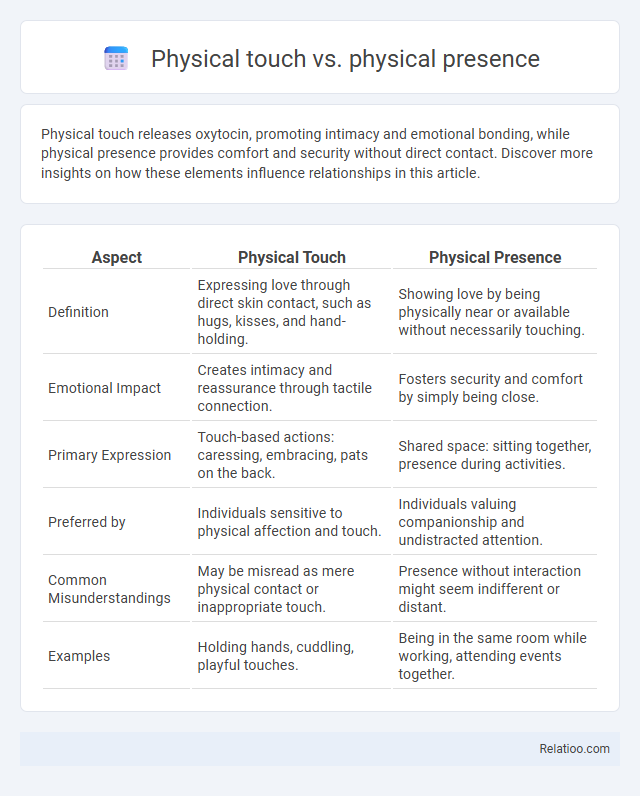Physical touch releases oxytocin, promoting intimacy and emotional bonding, while physical presence provides comfort and security without direct contact. Discover more insights on how these elements influence relationships in this article.
Table of Comparison
| Aspect | Physical Touch | Physical Presence |
|---|---|---|
| Definition | Expressing love through direct skin contact, such as hugs, kisses, and hand-holding. | Showing love by being physically near or available without necessarily touching. |
| Emotional Impact | Creates intimacy and reassurance through tactile connection. | Fosters security and comfort by simply being close. |
| Primary Expression | Touch-based actions: caressing, embracing, pats on the back. | Shared space: sitting together, presence during activities. |
| Preferred by | Individuals sensitive to physical affection and touch. | Individuals valuing companionship and undistracted attention. |
| Common Misunderstandings | May be misread as mere physical contact or inappropriate touch. | Presence without interaction might seem indifferent or distant. |
| Examples | Holding hands, cuddling, playful touches. | Being in the same room while working, attending events together. |
Understanding Physical Touch: Definition and Importance
Understanding physical touch involves recognizing it as direct bodily contact that fosters emotional connection and conveys empathy beyond words, playing a crucial role in human bonding and communication. Physical presence, in contrast, simply refers to being near someone without necessarily engaging in tactile interaction, which can influence feelings of security and attentiveness. Your ability to distinguish between these concepts enhances relationships by aligning your communication style with the emotional needs and comfort levels of others.
The Role of Physical Presence in Human Connection
Physical presence plays a crucial role in fostering deep human connection by enabling non-verbal cues such as body language, facial expressions, and eye contact, which are essential for emotional understanding and empathy. While physical touch enhances intimacy and comfort, being physically present allows for a comprehensive sensory experience that strengthens trust and social bonding. The combination of physical presence with meaningful interactions significantly improves communication quality and emotional resonance in relationships.
Psychological Effects of Physical Touch
Physical touch significantly influences psychological well-being by releasing oxytocin, reducing stress, and fostering feelings of trust and security, which physical presence alone may not fully achieve. Your mental health benefits from regular physical contact, as it can alleviate anxiety, depression, and enhance bonding in relationships. While physical presence provides comfort and support, the unique sensory input from touch plays a crucial role in emotional regulation and social connection.
Emotional Impact of Physical Presence
Physical presence offers a profound emotional impact that physical touch alone cannot achieve, as being physically present allows for nonverbal communication, such as body language and eye contact, which strengthens emotional connections. Your emotional well-being benefits more from genuine physical presence because it signals attention, empathy, and support beyond the limitations of touch. Research shows that physical presence enhances feelings of security and belonging, making interpersonal relationships more resilient and emotionally fulfilling.
Physical Touch vs Physical Presence in Relationships
Physical touch in relationships enhances emotional intimacy by triggering oxytocin release, fostering trust and bonding. Physical presence, while important for shared experiences and non-verbal communication, may lack the immediate emotional impact that touch provides. Understanding the unique roles of physical touch and presence can help you strengthen your connection and meet your partner's emotional needs more effectively.
Communication through Touch vs Presence
Communication through touch conveys empathy, reassurance, and connection by engaging the somatosensory system, making it a powerful nonverbal tool in relationships. Physical presence enhances communication by providing visual and contextual cues, fostering attentiveness and emotional understanding beyond words. Your interactions benefit most when you combine touch and presence, as the synergy deepens trust and strengthens emotional bonds.
Physical Touch in Different Cultures
Physical touch varies significantly across cultures, influencing how warmth, comfort, and connection are expressed in social interactions. In Mediterranean and Latin American cultures, frequent physical touch like hugs and kisses on the cheek symbolize friendliness and closeness, while in many East Asian cultures, touch is more reserved to maintain respect and personal space. Understanding these cultural nuances can help you navigate social situations sensitively and build stronger interpersonal relationships worldwide.
Challenges of Maintaining Connection Without Physical Touch
Physical presence allows you to sense someone's energy through proximity, but without physical touch, forming deep bonds can be challenging due to the lack of tactile cues that reinforce emotional connection. Physical touch triggers oxytocin release, essential for intimacy and stress reduction, which absence can intensify feelings of loneliness and emotional distance in relationships. Maintaining connection requires heightened communication skills and alternative nonverbal signals such as eye contact and tone of voice to compensate for the missing physical contact.
Benefits and Limitations of Physical Presence
Physical presence enhances communication through non-verbal cues such as body language and eye contact, fostering deeper emotional connections and trust during interactions. You gain immediate feedback and a richer sensory experience that virtual interactions or mere physical touch alone cannot fully replicate. However, physical presence requires time, effort, and sometimes geographic proximity, which can limit accessibility and convenience compared to remote communication methods.
Choosing the Right Connection: When Touch Matters More
Physical touch creates a deeper emotional connection by releasing oxytocin, enhancing feelings of trust and bonding, which often surpasses the impact of mere physical presence. Your choice between physical touch and presence depends largely on the context and the emotional needs involved, with touch being crucial in moments requiring comfort or reassurance. Understanding when touch matters more can significantly improve relationship quality by fostering intimacy and emotional support beyond just being physically near.

Infographic: Physical touch vs Physical presence
 relatioo.com
relatioo.com